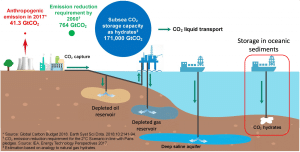Researchers from IIT Madras have discovered that the Indian Ocean could be a promising site for storing massive amounts of carbon dioxide permanently. They propose CO2 storage in liquid pools or solid hydrates at certain depths, which they believe won’t harm the marine ecosystems. This strategy could aid India in decarbonizing its industrial hubs and achieving its 2070 net-zero target.
Unlocking the Research Insights of the Indian Ocean’s CO2 Storage Potential
Many renowned oceanographers have noted that, among all the world’s oceans, the Indian Ocean is possibly the most under-researched. CCS involves capturing CO2 emissions from industrial sources or the atmosphere and storing them deep underground or in oceanic reservoirs.
Currently, IIT-Madras is exploring the carbon sequestration capacity of this ocean basin. Here are the key points from their findings:
CO2 Storage Capacity
Researchers have estimated that the Bay of Bengal, the northeastern part of the Indian Ocean could alone sequester several hundred gigatons of anthropogenic CO2 in ocean and marine sediments. This quantity is equal to the total greenhouse gas emissions produced by India over several years.
- READ MORE: Carbon Dioxide Removal (CDR) and Carbon Capture and Storage (CCS): A Primer (carboncredits.com)
CO2 Storage Forms
The research findings further state that stored CO2 can exist in two forms:
Gas Hydrates: Beyond a certain depth (deeper than 500 meters), the stored CO2 can form an environmentally friendly ice-like substance known as “gas hydrates”. Under oceanic conditions, approximately 150-170 cubic meters of CO2 can be sequestered by one cubic meter of gas hydrate.
Liquid Pools and Solid Hydrates: At depths exceeding 2800 meters, CO2 can be permanently stored as liquid pools and solid hydrates. Once converted into gas hydrate, CO2 cannot escape into the atmosphere due to gravitational and hydrate permeability barriers within the subsea sediments.
Professor Jitendra Sangwai, Dept of Chemical Engineering, IIT Madras spearheading the research has identified the foundation of the study. He said,
“Methane hydrate have been in the ocean for millions of years without affecting the environment. Methane is more potent GHG than CO2. This attracts researchers to explore the ocean to store CO2 permanently.”
IIT Madras’ research provides crucial insights into optimizing CO2 storage strategies. By examining factors such as clay concentration, additive properties, and local ocean floor characteristics, researchers can identify the most efficient methods for subsea CO2 sequestration.
This pioneering research from IIT Madras offers significant promise for India’s efforts against climate change. By leveraging the Indian Ocean and Bay of Bengal’s CO2 storage potential, India can take strides towards its decarbonization goals and pave the way for a more sustainable future.
A similar study was conducted at the National University of Singapore. The research team at NUS said that this technology has the potential to evolve into a commercial-scale process. It could enable countries like Singapore to efficiently sequester more than 2MTs of CO2 annually as hydrates to meet emission reduction targets.
This image will define the process of storing CO2 in oceans.
Ensuring the Safety of the Marine Ecosystem
While using the ocean as a CO2 storage sink is attractive, direct storage at shallow depths could harm marine life. Therefore, they need to store the CO2 permanently in the ocean at specific depths or at sub-sea sediments to avoid ecological damage to the Indian Ocean, Bay of Bengal, and surrounding coastal areas.
Mr. Yogendra Kumar Mishra, a research scholar at IIT Madras has pointed out,
“There are various methods for CO2 sequestration,” said “While the ocean presents a viable storage solution, directly injecting CO2 into shallow waters can harm marine life. Our research explores permanent storage options at greater depths.”
Oceanic Carbon Capture Bolstering India’s Pledge to Net Zero
However, India is looking for a long-term and large-scale CO2 sequestration technology to decarbonize heavy industries like power, steel, and transport. Oceanic CO2 capture has massive potential to transition toward carbon neutrality.
Looking back, Europe adapted this approach to store CO2 in the North Sea. Northern European countries like Denmark and Norway are actively implementing carbon sequestration initiatives in the North Sea. These programs involve capturing CO2 and storing it in old oil and gas reservoirs or saline aquifers beneath the seabed. Most CCS programs are governed by the laws of the hosting country, despite some efforts toward international cooperation.
Similarly, the Indian Ocean and the Bay of Bengal offer vast expanses where captured CO2 can be safely stored, potentially mitigating the impacts of climate change.
As governments commit to achieving net-zero carbon emissions by 2050, they are addressing the challenge of managing residual CO2 emissions, particularly from heavy industries.
India’s pursuit of CCS technology for ocean CO2 capture aligns with its broader climate goals. It includes the country’s commitment to achieve net-zero emissions by 2070.
By investing in CCS initiatives’ research, development, and implementation, India aims to shrink its carbon footprint and contribute to global climate change.
In summary, this research provides a promising avenue for addressing climate change by leveraging the vast potential of the Indian Ocean’s CO2 storage and sequestration.


